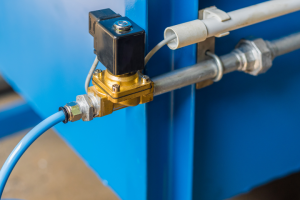
Direction control valve solenoids are an important part of many automated hydraulic systems, allowing the controlled movement of fluid and other materials in a variety of directions. Like any mechanical component, however, they are prone to failure over time. In this article, we address the age-old question: what could go wrong with a direction control valve solenoid?
1) Worn Out Parts
The most common reason for a direction control solenoid to fail is simply that its parts have worn out over successive uses. This can arise through normal wear and tear, or even incorrect use or installation. It’s important to inspect your solenoids regularly to ensure that all the components are working correctly and that there are no signs of visible wear, or unexpected drop in performance. If you do detect signs of wear, it’s best to replace the worn-out parts immediately to avoid further damage and unscheduled downtime.
2) Contamination
Another common cause of direction control solenoid failure is contamination from dirt, dust, or debris. To keep your solenoid functioning properly, it’s vital to always keep it clean and free from contaminants. Regularly inspect the production area around your solenoid, as well as the wider hydraulic system, for any debris or dirt build-up, and be sure to remove potential contaminants immediately if you find any.
3) Power Surge/Voltage Drop
A power surge or voltage drop can also cause direction control valve solenoids to fail. These surges or drops in power can damage the delicate circuitry inside the solenoid, leading to permanent damage or failure. This often happens when an undersized power supply is used with the system; if not enough voltage is sent through the coil, then it won’t generate enough force for proper operation. You can also guard your components from surges by installing an appropriate surge protector on your system and checking its voltage levels regularly.
4) Poor Maintenance Practices
Inadequate maintenance practices can lead to issues going undetected that can eventually lead to solenoid failure. By implementing a good maintenance schedule – using either preventative or predictive maintenance processes, you’ll help ensure that your system runs smoothly and efficiently without any unexpected failures. Your maintenance schedule should include regular visual inspections, as well as cleaning and lubricating moving parts when necessary.
5) Faulty Connections
Direction control solenoids rely on a consistent electrical current to function properly, and if there’s an issue with the wiring or if something is loose or disconnected, this can cause the solenoid to temporarily malfunction or fail altogether. Inspect all electrical connections regularly for signs of corrosion or wear and tear that could be causing issues with your system.
6) Overheating
Your solenoid can overheat when too much current is sent through the coil, causing it to become too hot and burn out. This problem can be avoided by ensuring that your hydraulic system has adequate cooling provisions in place: high-power systems may require a heat sink or fan coolers to help dissipate heat from the coil more efficiently.
7) Excessive Vibrations
Excessive vibrations can cause long-term mechanical damage due to excessive wear and tear and strain placed on the components. This is especially true in systems that are exposed to drastic temperature fluctuations or high levels of external vibrations, such as machinery used on busy production lines. Fit your system with adequate shock absorbers or dampeners between any moving parts to reduce vibrations and minimise wear.
Hydraulic Design Support From Hydrastar
As hydraulic design specialists, we support our customers to create and maintain efficient and high value fluid power systems with strong productivity levels and minimal maintenance requirements. For more information about control systems, fault diagnosis, and risk mitigation, please call today on 01353 721704.
Image Source: Canva


